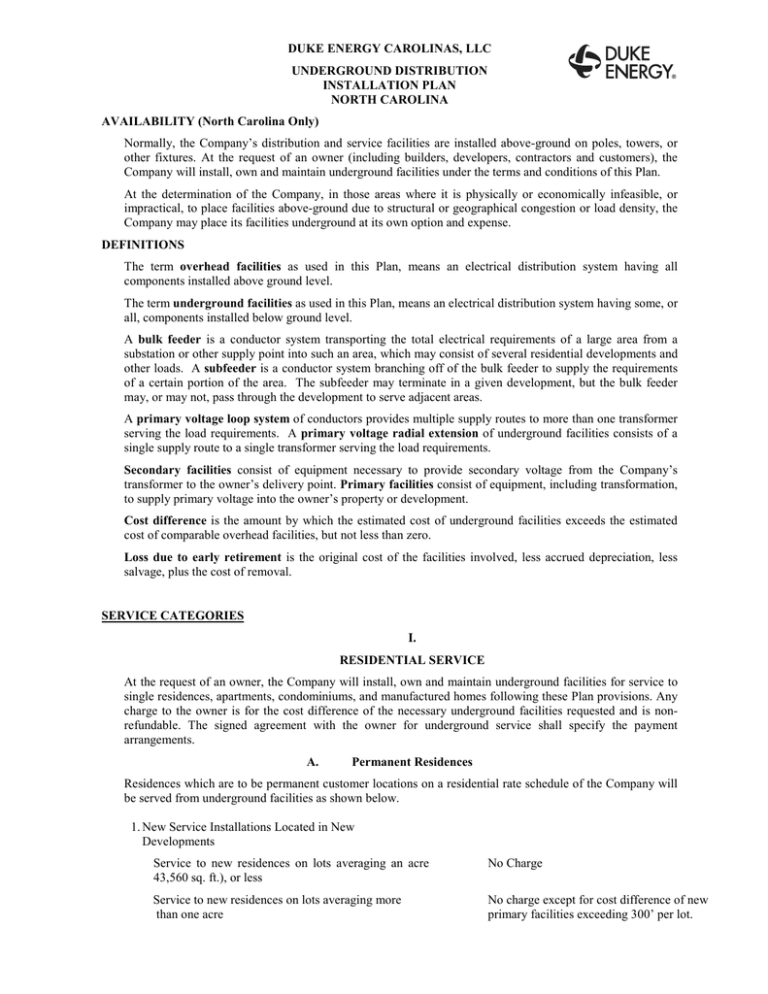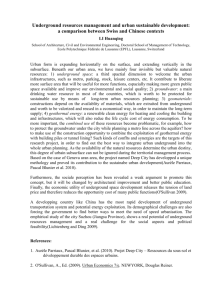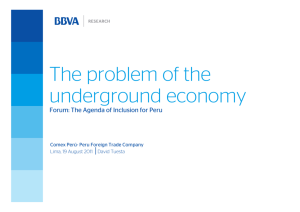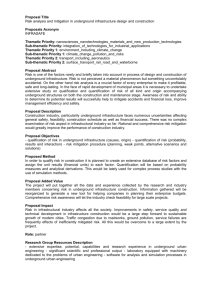North Carolina
advertisement

DUKE ENERGY CAROLINAS, LLC UNDERGROUND DISTRIBUTION INSTALLATION PLAN NORTH CAROLINA AVAILABILITY (North Carolina Only) Normally, the Company’s distribution and service facilities are installed above-ground on poles, towers, or other fixtures. At the request of an owner (including builders, developers, contractors and customers), the Company will install, own and maintain underground facilities under the terms and conditions of this Plan. At the determination of the Company, in those areas where it is physically or economically infeasible, or impractical, to place facilities above-ground due to structural or geographical congestion or load density, the Company may place its facilities underground at its own option and expense. DEFINITIONS The term overhead facilities as used in this Plan, means an electrical distribution system having all components installed above ground level. The term underground facilities as used in this Plan, means an electrical distribution system having some, or all, components installed below ground level. A bulk feeder is a conductor system transporting the total electrical requirements of a large area from a substation or other supply point into such an area, which may consist of several residential developments and other loads. A subfeeder is a conductor system branching off of the bulk feeder to supply the requirements of a certain portion of the area. The subfeeder may terminate in a given development, but the bulk feeder may, or may not, pass through the development to serve adjacent areas. A primary voltage loop system of conductors provides multiple supply routes to more than one transformer serving the load requirements. A primary voltage radial extension of underground facilities consists of a single supply route to a single transformer serving the load requirements. Secondary facilities consist of equipment necessary to provide secondary voltage from the Company’s transformer to the owner’s delivery point. Primary facilities consist of equipment, including transformation, to supply primary voltage into the owner’s property or development. Cost difference is the amount by which the estimated cost of underground facilities exceeds the estimated cost of comparable overhead facilities, but not less than zero. Loss due to early retirement is the original cost of the facilities involved, less accrued depreciation, less salvage, plus the cost of removal. SERVICE CATEGORIES I. RESIDENTIAL SERVICE At the request of an owner, the Company will install, own and maintain underground facilities for service to single residences, apartments, condominiums, and manufactured homes following these Plan provisions. Any charge to the owner is for the cost difference of the necessary underground facilities requested and is nonrefundable. The signed agreement with the owner for underground service shall specify the payment arrangements. A. Permanent Residences Residences which are to be permanent customer locations on a residential rate schedule of the Company will be served from underground facilities as shown below. 1. New Service Installations Located in New Developments Service to new residences on lots averaging an acre 43,560 sq. ft.), or less No Charge Service to new residences on lots averaging more than one acre No charge except for cost difference of new primary facilities exceeding 300’ per lot. 2. New Service Installations Not Located in New Developments Service to new residences requiring new underground secondary voltage facilities from an above-ground distribution line on, or adjacent to, the lot on which the residence is located. No Charge Service to new residences requiring new underground primary and secondary voltage facilities No charge except for cost difference of new primary facilities exceeding 300’. 3. New Three-Phase Service Installations Three-phase service to new single-residence structures, where this type of service is available. No charge except for cost primary difference of new primary facilities exceeding 300’. Three-phase service to new multi-residence structures, where this type of service is available. No Charge B. Other Residences Residences which are in service categories not described above, will be served from underground facilities installed, owned, and maintained by the Company under an agreement with the owner providing for payment to the Company of the charges, if any, equal to the cost difference. II. NON-RESIDENTIAL SERVICE At the request of an owner, the Company will install, own and maintain underground facilities to new general service and industrial service installations following these Plan provisions. Any charge to the owner is for the cost difference of the necessary underground facilities requested and is non-refundable. The signed agreement with the owner for underground service shall specify the payment arrangements. 1. New Service Installations Requiring Only Secondary Voltage Facilities No Charge 2. New Service Installations Requiring Primary Voltage Loop System Facilities 3. New Service Installations Requiring Primary Voltage Radial Extension Facilities No Charge 4. New Bulk Feeder and Subfeeders Cost difference of such primary facilities. No charge except for cost difference of single-phase primary facilities exceeding 300’, or three-phase primary facilities exceeding 500’. For three-phase primary facilities exceeding 500’, additional underground footage will be provided at no charge when installation of underground facilities is less than comparable overhead facilities. CONVERSION TO UNDERGROUND The Company will replace an existing overhead distribution system with an underground system in an existing residential development or other area under the following terms and conditions: 1. The Company shall place facilities underground by an agreement with the requesting persons which provides for payment of a nonrefundable, contribution-in-aid-of-construction as follows: a. b. When the existing overhead distribution system is not adequate to supply the customer’s load due to added electrical load, the contribution in aid of construction shall be equal to the cost difference between comparable overhead and underground facilities. When the existing overhead distribution system is adequate to supply the customer’s load, the contribution in aid of construction shall be equal to the cost of comparable underground facilities, less any salvage value of the overhead system. 2. Preliminary engineering studies are necessary to determine the approximate costs of replacing overhead with underground facilities. Persons requesting replacement of such facilities shall pay, prior to commencement of such studies by the Company, a good faith, nonrefundable deposit in an amount of $100 for each 600’ of front lot lines for residential development studies, and, for studies of all other service areas, the estimated cost of the preliminary engineering study. If the replacement is undertaken following completion of such studies, actual costs, including preliminary engineering studies, will be charged and credit will be given for the estimated costs, or deposit, which was advanced. 3. The Company need not replace existing overhead systems with underground facilities, except individual services from pole to residence, unless at least one block or 600’ of front lot line is involved, whichever is less. 4. All customers served directly from the specific section of line or in the area to be replaced with underground facilities shall agree to the conditions outlined for replacement of overhead facilities. Owners shall arrange the wiring of their structures to receive underground service at meter locations which allow unimpeded installation of the underground service facilities. 5. ESTIMATES Estimates of the cost of the underground and overhead facilities for the purpose of determining the amount of the contribution-in-aid-of-construction will be in accord with the Company’s current construction design practices and shall be based upon the equivalent conductor and transformer capacity required for the electrical load specified by the owner. GENERAL PROVISIONS 1. Facilities associated with an underground distribution system, other than the conductors, may be installed above or below ground level as determined solely by the Company in accord with the current construction design practices of the Company. 2. The Company will normally not provide underground service at secondary voltages above 480 volts. 3. The Company will provide service to a single transformer using a loop system design at the request of the owner who desires to have a loop system installed and makes a payment equal to the estimated cost of the additional facilities in excess of the radial extension facilities. 4. Existing overhead distribution bulk feeders will remain installed overhead unless the owner desires to have them installed underground. New bulk feeders necessary to serve a new underground residential subdivision will be installed overhead unless the owner desires to have them installed underground, and makes a contribution-in-aid-of-construction equal to the estimated cost difference between underground and overhead facilities. If it is necessary to extend a distribution bulk feeder through an existing underground residential development, it will be installed underground at Company expense. 5. New subfeeders necessary to serve a new underground subdivision or development will be installed underground inside such areas at no charge. New subfeeders outside such areas normally will be installed overhead, unless the owner desires to have them installed underground and makes a payment equal to the estimated cost difference. 6. Developments shall be divided into established and defined lots. For purposes of determining service categories, the average size of lots shall be expressed in square feet. 7. Prior to the installation of the underground distribution system by the Company, the final grade levels of the building sites shall be established by the owner. The building construction program shall be coordinated with the installation of underground electrical facilities to permit unimpeded access of the Company’s equipment to the installation sites; to allow installation of underground facilities at proper depth and before streets, curbs or other obstructions are installed; and to eliminate dig-ins to the underground electrical facilities after installation. Should streets, curbs or other obstructions be present prior to installation of underground facilities, resulting in additional expense to the Company, payment for these additional expenses shall be made to the Company by the owner. Should established lots or final grade levels change after installation of underground electrical facilities has begun, or if installation of electrical facilities is required by the owner before final grades are established, and either of these conditions results in additional expenses to the Company, payment for these additional expenses shall be made to the Company by the owner. 8. Should existing sidewalks, septic tank systems, fuel tanks, other utility line, or other man-made obstructions result in additional expenses to the Company, payment for same will be made by the owner. 9. Actual costs brought about in connection with the compliance of special requirements, if any, of municipalities, State and Federal highway agencies or departments regarding the breaking of pavement, ditching backfilling, and other related conditions, will be paid by the owner. 10. The Company will make, or adjust, charges to the owner to collect the actual additional costs to the Company due to adverse conditions, such as: the composition of the land where the underground facilities are to be installed is such that standard construction equipment cannot be used to complete the installation; or, special equipment and materials are needed for stream crossing structures or concrete structures; or, dynamite is required; or, if abrupt changes in final grade levels exceed a slope ratio of 1 when measured within three feet of the trench. 11. The Company’s agreement to provide underground service is dependent upon the securing of all necessary rights, easements, rights-of-way, privileges, franchises or permits for the installation of such service from those requesting the underground facilities. The Company shall exercise care in the utilization of its underground equipment during construction, but the ultimate responsibility for the protection of shrubs, trees, and grass sod will be with the owner. Shrubs, trees, or any other obstacle shall not be placed within ten feet of transformer or cabinet openings which would hinder the access of the Company at any time. 12. Temporary service will not be available in the area served from underground facilities until the underground system is in place unless the owner elects to pay the in and out costs of temporary facilities necessary to deliver the temporary service from overhead distribution lines. After the underground facilities are in place, temporary service may be provided for no charge only at a transformer or pedestal location. 13. Underground conductors to provide service to Company-owned outdoor lighting will be furnished under the applicable rate schedule on file with and approved by the Commission. 14. The Company will provide and coordinate underground service facilities with other requested facilities which are supplied under the Extra Facilities provision of the Company’s Service Regulations. 15. The Company may in its discretion limit installation of the Company’s electrical facilities in a residential or non-residential development to that area which, in the Company’s judgment, is likely to be occupied within a reasonable period of time, in order to avoid excess investment in idle facilities. The developer may obtain installation in the additional area by paying the applicable cost under this Plan for the development as a whole plus an Idle Facilities Deposit. The Idle Facilities Deposit is for the area deemed not likely to be occupied in a reasonable time less applicable costs under this Plan. Idle Facilities deposits will be reviewed annually by the Company and will be refunded, with interest, based on the pro-rata portion of the Company’s idle facilities needed to serve Owners during the preceding 12 months. Any deposit held by the Company for five years or more shall not be refunded. The five year period shall start upon completion of construction and availability of electric service. In the event the Owner, at his request, delays, either temporarily or indefinitely, the installation of the Company’s underground facilities such that installation of said facilities cannot be completed, the Company reserves the option to begin the five year period when sufficient facilities are installed to serve customer additions. 16. In areas where the Company’s standard design requires that underground conductors be placed in concrete-encased duct systems, typically designated downtown areas, the Company will bear the expense of the concrete-encased duct system on public easements. Where the design to meet the owner’s request requires the concrete-encased duct system to be extended onto private property, the owner will provide, or will make payment to the Company for, the appropriate concrete-encased duct system to the Company’s specification. Effective January 1, 2008 NCUC Docket No. E-7, Sub 828 ©2013 Duke Energy Corporation 2/13-LU





